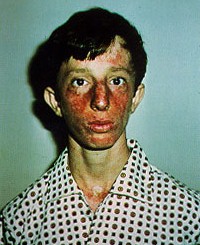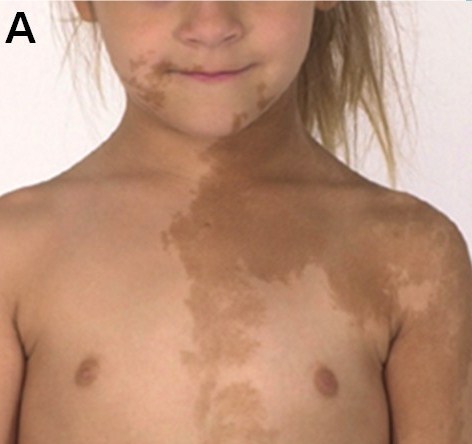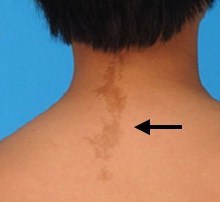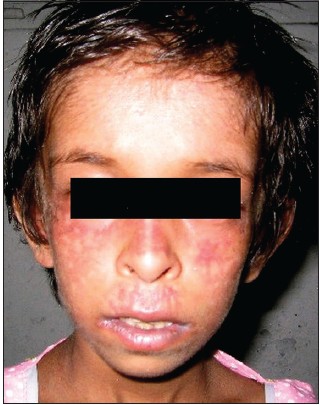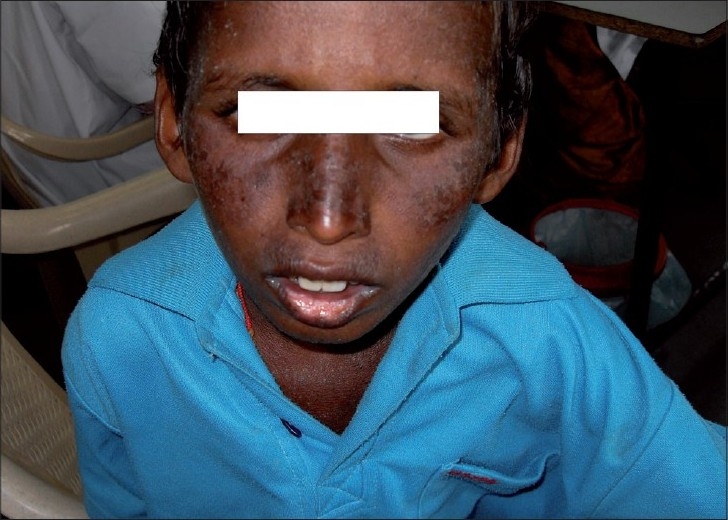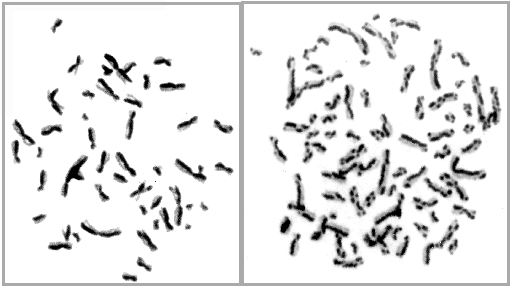Bloom's Syndrome (BSyn)
Bloom's Syndrome, or BSyn, is a rare genetic disorder that belongs to a group of conditions called chromosomal breakage syndromes. This term means that the chromosomes of affected people are unstable and can break easily. Other members of this group are ataxia telangiectasia, Nijmegen breakage syndrome, and Fanconi anemia. All of the conditions in this group are very rare, and they all increase the risk of cancer.
Bloom's syndrome is also classified as a DNA repair disorder. Disorders in this group are characterized by abnormalities of DNA repair, which may make a person's cells unable to fix certain kinds of damage to DNA. DNA is constantly damaged by processes inside and outside of cells. External agents include UV light, ionizing radiation, and many chemicals (e.g. smoke, soot, and vinyl chloride, which is used to make PVC). Internal processes include normal biochemical reactions inside cells, thermal processes/heat, and other activities of normal cellular metabolism. In fact, there are so many natural things and processes that damage DNA, the problem is routine and universal. As a result, living things have evolved many ways to fix the damage. Unfortunately, people with one ore more of these ways is damaged in DNA repair disorders, and the damage accumulates. Unsurprisingly, and as with the chromosomal breakage syndromes, increased cancer risk is a common part of these diseases. Other members of this group include include Cockayne syndrome, trichothiodystrophy, and xeroderma pigmentosum.
Bloom syndrome is a very rare disorder, with roughly 300 cases known worldwide (1). It is somewhat less rare among people of Ashkenazi Jewish origin (2), and roughly one-third of all patients are members of this group (3). In addition, it estimated that ~1% of Ashkenazi Jews are carriers (4). Carrier frequency may also be higher among Japanese people (5), though it is not as high as it is in the Ashkenazi population.
An international registry for Bloom's syndrome was established in the early 1960s (6). As of 2012, 272 people were registered in it (1). Advantages of registries are that include the ability to notify members about clinical trials and the creation of a repository of information that helps researchers understand a disease. A limited amount of summary data about complications of BSyn from the year 2009 is available on the Bloom's syndrome registry site.
Clinical information
Signs of Bloom's syndrome may be observed during pregnancy, when ultrasound may reveal that the fetus is much smaller than expected. However, given that this abnormality occurs in 3-7% of infants (7), small size itself does not mean that an infant has Bloom's syndrome.
People with BSyn may not feed well during infancy and tend to gain weight poorly. In some cases, tube feeding may be required. In addition, a cardinal feature of the syndrome is the appearance of a rash-like lesion over the nose and cheeks. This sign tends to appear after exposure to the sun, and is typically described as being butterfly-shaped. Facial lesions occur in a large majority of patients, but not all of them. Other clinical features of BSyn are listed below.
- A butterfly-shaped rash over the nose and cheeks
- Lip lesions with blisters and/or fissures
- Small or very small size at birth
- Failure to thrive in infancy
- Very short stature
- Very small head
- Skin telangiectasias (spidery veins visible near the surface of the skin)
- Café au lait spots on the skin (see photo)
- Immunoglobulin A, M, and/or G deficiency
- Frequent infections
- Long, narrow face
- Photosensitivity
- Cancer
Common clinical features of Bloom syndrome
In spite of their very small size, growth hormone levels are normal in children with BSyn (1). To date, no one has found an intervention that increases height in this patient group. For example, growth horomone therapy has been tried and found to be ineffective. In addition, tube feeding helps with weight gain, but does not affect height.
Most people with Bloom's syndrome have normal intelligence, although a minority have intellectual disabilities. Many patients with normal intelligence however, are described as being uninterested in learning (1); they may also have problems with abstract thinking (1).
The prognosis for BSyn is generally poor, although some patients have lived into their 40sor even late 40s. Reduced life expectancy is due to life-threatening complications of syndrome, which include immunodeficiency and increased cancer risk. Immunodeficiency makes patients susceptible to frequent respiratory, gastrointestinal, and ear infections. In particular, respiratory infections may include pneumonia. Although this condtion may be treated with antibiotics, the Bloom's syndrome registry reports that, out of 265 patients registered in 2009, 5 had succumbed to chronic obstructive lung disease. In addition, 122 peope had been diagnosed with cancer (including leukemia, skin cancer, lymphomas, and others). When treating cancers, standard therapies are employed, but doses of radiation and certain medications may have to be reduced due to DNA repair defects (1). Length of treatment may also have to be reduced (1). Clinicians should ensure that patients are checked frequently for signs of cancer or chronic lung disease.
Diabetes is another potentially life-threatening condition associated with Bloom's syndrome, and was reported in ~18% of registered patients in 2012 (47 cases out of 272 in the registry; 1).Although it tends to be mild in BSyn patients, serious complications have occured, and blood sugar levels in patients should be monitored carefully.
Cause
BSyn is an autosomal recessive disorder caused by mutations in the gene BLM (8). The term autosomal recessive means that the syndrome occurs when only both parents carry a mutated copy of a gene, and each passes the mutated copy to a child. In this situation, each parent will have one copy of the gene with the mutation and one copy of the gene without the mutation. This means that there is a one chance in four that future children will also have BSyn. People who are carriers do not show signs of the syndrome.
To date, BLM is the only gene associated with Bloom's syndrome.
Diagnosis and Testing
The standard method for confirming a diagnosis of Bloom's syndrome is sister chromatid exchange (SCE) analysis (1). The term sister chromatid exchange refers to the exhange of genetic material between identical ("sister") chromatids during mitosis. To perform the test, cells (usually blood cells) from a patient are cultured and exposed to a substance called 5'bromo-2'-deoxyuridine. After a period of time, the chromosomes in the cells are stained and analyzed. In people who do not have BSyn, levels of SCE are very low (<10 per metaphase). In Bloom's syndrome, rates are 10-100 times higher than in the normal population (9). Bloom's syndrome is the only known condition in which SCEs increase under these circumstances (1). Another test used to diagnose the syndrome uses blood lymphocytes and look for a chromatid configuration called quadriradial, or Qr. The use of both tests is encouraged (1).
Bloom's syndrome may also be confirmed by using genetic sequencing to search for mutations in BLM. A variety of mutations have been found in BSyn patients. However, it is noteworthy that a single mutation seems to occur in Ashkenazi Jews (c.2207_2212delinsTAGATTC; 10). This mutation has also been found in people who are not members of this group (11).
Differential Diagnosis
A number of diseases cause skin manifestations that resemble the ones in BSyn. Laboratory testing for SCEs can distinguish all of these conditions from BSyn.
Rothmund-Thomson syndrome (RTS) is a rare condition that shares many similarities with Bloom syndrome. For example, RTS and BSyn patients are often very small from the time of birth and are sensitive to light. Like Bloom syndrome patients, they may also develop a facial rash with telangiectasias and blistering on sun-exposed skin. This rash can look similar to the rash in BSyn. In addition, patients with both syndromes tend to have normal intelligence. Features that may help distinguish the two diseases include the high-pitched voice that is very common in Bloom syndrome, but not RTS, and the hair loss that is common in RTS but not BSyn. In addition, RTS patients tend to have skeletal abnormalities that are not associated with Bloom's syndrome, such as thumb, wrist, and kneecap abnormalities. Cataracts occurs in many RTS patients, but is not associated with BSyn.
Laboratory testing can distinguish RTS and Bloom syndrome. RTS is caused by mutations in the gene RECQL4, where as Bloom's is caused by mutations in BLM. In addition, as noted above, SCE analysis is a standard test for confirming a diagnosis of Bloom's syndrome; results in RTS patients will be normal.
Russell-Silver syndrome (RSS). RSS is a rare disorder that causes small size from birth. RSS patietns, like Bloom's syndrome patients, may also have café-au-lait spots on their skin, feeding problems, intellectual disabilities, and blood sugar abnormalities. The testes may be undescended in males with both conditions. Clinical features that can help distinguish the two include normal head circumference in RSS compared with microcephaly in BSyn, and asymmetry of the face, limbs or body in RSS but not Bloom's. Testing can also distinguish the two syndromes.
Xeroderma pigmentosum (XP). XP is a rare disorder that, like BSyn, causes sensitivity to ultraviolet/UV light. Many people with XP can be severely sunburned after brief exposures to sunlight, with some even burning if they stay in the shade. Some people with XP do not have this problem, but the sensitivity to UV light is still present, and is still very dangerous. XP patients are unable to repair the damage that UV light does to DNA. The result is that they are highly susceptible to skin cancer, with a risk that is 10,000 times the risk for unaffected people (reviewed in Lehmann2011). XP patients may develop skin telangiectasias. Freckling in sun-exposed areas is common, and is often followed later by actinic keratoses. The latter, especially in combination with telangiectasias or a burn, may resemble skin abnormalities due to BSyn. Differences between the two conditions include a lack of café-au-lait spots in XP and normal intelligence in XP that, unlike BSyn, is not associated with lack of interest in learning.
Cockayne syndrome (CS). CS is a very rare disorder that also causes sensitivity to ultraviolet/UV light. Many people with CS can be severely sunburned after brief exposures to sunlight, though some can go outside when covered with clothing or sunscreen. Unlike BSyn patients, people with Cockayne syndrome do not have an increased cancer risk, and they do not develop the skin lesions that are characteristic of XP (12). Note that people with the extremely rare XP-CS complex are susceptible to cancer (see below). CS patients have a recognizable facial appearance that can be very similar to that of people with BSyn. For example, a narrow face and lack of adipose tissue creates a wizened appearance in both patient groups. The moderate and severe forms of CS are easy to distinguish from BSyn in that the CS patients have severe to profound intellectual and motor disabilites, as well as extremely short stature (the average in moderate CS was 104 cm in a group of 16 year-old patients (12); severely affected patients do not generally survive past age 8). Mildy affected CS patients are taller and have highly pitched voices; speech disorders including dysarthria may make them very difficult to understand. Mildly affected patients also have intellectual disabilities, though a very few may be only mildly affected or in the borderline range. Unlike BSyn, neurological problems in CS are progressive. In addition, CS patients do not develop facial lesions like those that are common in BSyn; an exception to this statement is that XP-CS patients do develop them on sun-exposed skin (see below).
XP-CS complex (XP-CS) is a combination of xeroderma pigmentosum and Cockayne syndrome. The clinical features described for each of these conditions occur in XP-CS: sensitivity to ultraviolet/UV light, the development of lesions on sun-exposed skin, very short stature, intellectual disabilities, and a predisposition to cancer (especially skin cancer). The neurological problems in XP-CS are progressive.
Werner syndrome (WS) is a rare genetic disease characterized by an appearance of premature aging combined with medical problems normally associated with older age. These problems generally begin to show around the time of adolescence, such as when a teenage growth spurt does not occur. Its clinical features include cataracts, premature greying of the hair and hair loss, and skin changes called scleroderma, which make the skin hard and tight. Like BSyn patients, WS patients have a high cancer risk (13). A key difference between the two syndromes is the age of onset: the clinical features of BSyn are generally apparent at birth, while the features of WS do not appear until adolescence. People with WS often develop type 2 diabetes, as well, a problem that is also generally associated with BSyn. WS is more common in people of Japanese and Sardinian descent.
References
- 1. Sanz MM & German J (2006) Bloom's Syndrome. Updated April 7, 2016. GeneReviews [Internet] Pagon RA et al., editors. Seattle (WA): University of Washington, Seattle; 1993-2021. Full text.
- 2. Cleary SP et al. (2003) Heterozygosity for the BLM(Ash) mutation and cancer risk. Cancer Res 63(8):1769-1771. Full text from publisher.
- 3. German J et al. (1996) Bloom's syndrome. XIX. Cytogenetic and population evidence for genetic heterogeneity. Clin Genet 49():223-231. Abstract on PubMed.
- 4. German J et al. (1977) Bloom's syndrome. VI. The disorder in Israel and an estimation of the gene frequency in the Ashkenazim. Am J Hum Genet 29(6):553-562. Full text on PubMed.
- 5. German J et al. (1984) Bloom's syndrome. XI. Progress report for 1983. Clin Genet 29(6):166-174. Abstract on PubMed.
- 6. The Bloom Syndrome Registry Weill Cornell Medical College.
- 7. Romo A et al. (2009) Intrauterine growth retardation (IUGR): epidemiology and etiology. Pediatr Endocrinol Rev 6 (Suppl. 3):332-336. Abstract on PubMed.
- 8. Ellis NA et al. (1995) The Bloom's syndrome gene product is homologous to RecQ helicases. Cell 483(4):655-666. Full text from publisher.
- 9. Schroeder TM & German J. (1974) Bloom's syndrome and Fanconi's anemia: demonstration of two distinctive patterns of chromosome disruption and rearrangement. Humangenetik 25(4):299-306. Abstract on PubMed.
- 10. Ellis NA et al. (1994) Linkage disequilibrium between the FES, D15S127, and BLM loci in Ashkenazi Jews with Bloom syndrome. Am J Hum Genet 55(3):453-460. Full text on PubMed.
- 11. Ellis NA et al. (1998) The Ashkenazic Jewish Bloom syndrome mutation blmAsh is present in non-Jewish Americans of Spanish ancestry. Am J Hum Genet 63(6):1685-1693. Full text on PubMed.
- 12. Natale V (2011) A comprehensive description of severity groups in Cockayne syndrome. Am J Med Genet Part A 155A(5):1081-1095. Full text from Forgotten Diseases.
- 13. Oshima J et al. (2002) Werner Syndrome. Updated September 29, 2016. GeneReviews [Internet] Pagon RA et al., editors. Seattle (WA): University of Washington, Seattle; 1993-2021. Full text.
- 14. Dumitrescu CE & Collins MT (2008) McCune-Albright syndrome. Orphanet J Rare Dis 3:12. doi: 10.1186/1750-1172-3-12. Full text on PubMed.
- 15. Relhan V et al. (2015) Bloom syndrome with extensive pulmonary involvement in a child. Indian J Dermatol 60(2):217. doi: 10.4103/0019-5154.152593. Full text on PubMed.
- 16. Singh A et al. (2010) The cytogenetics of Bloom's syndrome. J Pediatr Neurosci 5(2):171-172. Full text on PubMed.
- 17. Amor-Guéret M (2004) Bloom's syndrome. Orphanet Encyclopedia February 2004. Full text from Orphanet.
